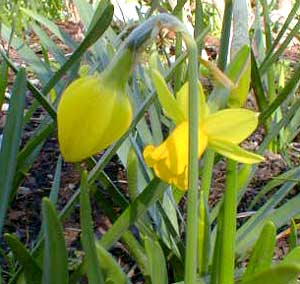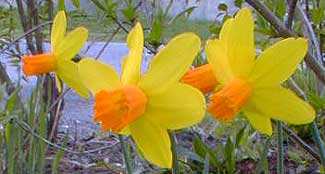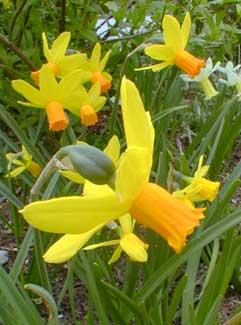
'Itzim'
Miniature Daffodil
"Yellow yellow daffodil dancing in the sun.
Oh yellow yellow daffodil, you tell me spring has come.
I can hear a blue bird sing, & hear a robin call.
But yellow yellow daffodil I love you most of all."
-Daffodil Song,
Author Unknown
Author Unknown
Narcissus x cyclamineus 'Itzim' was developed in the United States, released in 1982, & became a 1995 recipient of the Royal Horticultural Society's Award of Garden Merit.
Our small drift produces some that are a full foot tall & some that are six to eight inches tall, with two flower sizes as well. This is rather curious since the bulbs are planted together & do not have different conditions. Other drifts of single varieties tend always to match in size.
 I haven't found out for certain why this daffodil was named 'Itzim,' but I am leaping to the assumption that it is named for the Mayan sky-god & Lord of Knowledge, shown below left.
I haven't found out for certain why this daffodil was named 'Itzim,' but I am leaping to the assumption that it is named for the Mayan sky-god & Lord of Knowledge, shown below left.This Mayan divinity was called Itzim, Itzamna, or Itzim Na, meaning House (Na) of the Iguana (Itzim). The iguana was sacred to Itzamna, & any Mayan who killed such a sacred lizard could be put to death.
 Itzim taught gardening to the Mayans, including the cultivation of maize & cocao & the medicinal uses of herbs. He was said to have given the Mayans their entire culture, written language, & calendar. His bride was the snake-haired Ix Chel, Lady of Rainbows, goddess of healing, fertility, fate, earth, moon, & weaving. She was mother by Itzimna of the Mayan pantheon.
Itzim taught gardening to the Mayans, including the cultivation of maize & cocao & the medicinal uses of herbs. He was said to have given the Mayans their entire culture, written language, & calendar. His bride was the snake-haired Ix Chel, Lady of Rainbows, goddess of healing, fertility, fate, earth, moon, & weaving. She was mother by Itzimna of the Mayan pantheon.About fourteen 'Itzim' bulbs were planted in autumn in a streetside garden alongside about a dozen similar-sized 'Tracey,' at the foot of the twinberry bush. Stubby 'Tracey' bloomed first, in full sway by about mid-February. 'Itzim' began flowering toward the end of the first week in March (2005). A third cyclamineus daffodil extends the drift by the twinberry, & it begins to bloom after both 'Tracey' & 'Itzim,' namely the delicately slender-petalled 'Jack Snipe.'
Like the majority of cyclamineus daffodils, 'Itzim' blooms early in the year, a winter's end & early spring bloomer. Its gooseneck buds are fat in February, & a few days before it flowers, the buds turn into veritiable "balloons" of bright yellow & hold this balloon-like appearance for two or three days before the yellow petals "unzip" at the seams & fold backward to reveal the yellow trumpet. A typically bright bud is shown above in an early March photo, together with a freshly burst flower for which the trumpet has not yet begun to darken to orange.
 The narrow trumpets occur one per stem. The trumpets start out bright yellow as either the same color or only faintly darker than the deep yellow of the wide petals. But the trumpet ages to a rich orange, then continues to deepen its color by adding flecks of red, a habit aksi seen with 'Jetfire.' The darkening trumpets thrust forward from school-bus-yellow petals which are strongly reflexed.
The narrow trumpets occur one per stem. The trumpets start out bright yellow as either the same color or only faintly darker than the deep yellow of the wide petals. But the trumpet ages to a rich orange, then continues to deepen its color by adding flecks of red, a habit aksi seen with 'Jetfire.' The darkening trumpets thrust forward from school-bus-yellow petals which are strongly reflexed.'Itzim' is a little too much like 'Jetfire' to easily justify having them both. Although the unusual balloon-buds of 'Itzim' lend it a momentary distinction, 'Jetfire' is otherwise the better of the two, as it forms a more evenly-sized drift, plus 'Jetfire' darkens to orange-red more rapidly, & its petals reflex with better uniformly. 'Itzim' eventually sorts itself out with perfectly reflexed petals, but when the balloon-bud first zips open, the petals are a mite floppy for a day or two. The primary justification for both is that, in our garden at least, 'Jetfire' starts a week or so earlier, with 'Itzim' still aroun d a week or two later, collectively extending the presence of the type at least a half-month.
This adaptable cultivar is good in the open garden, for containers, & forces well indoors. It prefers loads of sun but will tolerate a little shade. It wants moisture in spring, dryness during summer dormancy, but the bulbs survive more wetness than do most cyclamineus or Division 6 bulbs, if such is inescapable.
They thrive in a wide range of temperatures (zones 4 through 9), but in zones where they wouldn't experience much of a winter they will need to be lifted late each summer, chilled, then replanted.
The flowers often but not invariably bow their heads, so that a grouping of 'Itzem' can give the impression of several Attention Deficit children wearing yellow rainslickers, whose wavering attention has them gazing up, down, left, right, & forward.